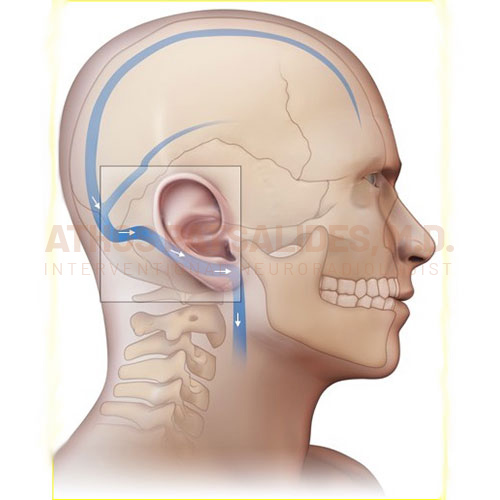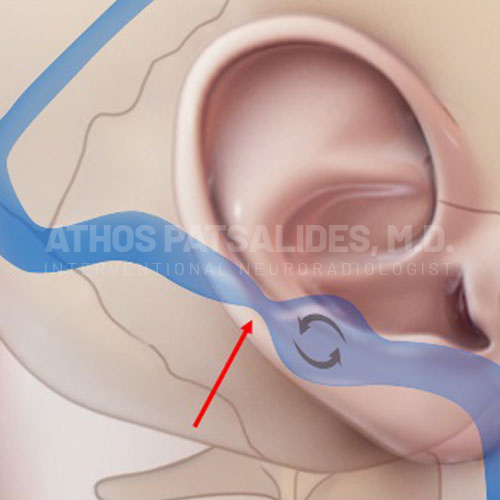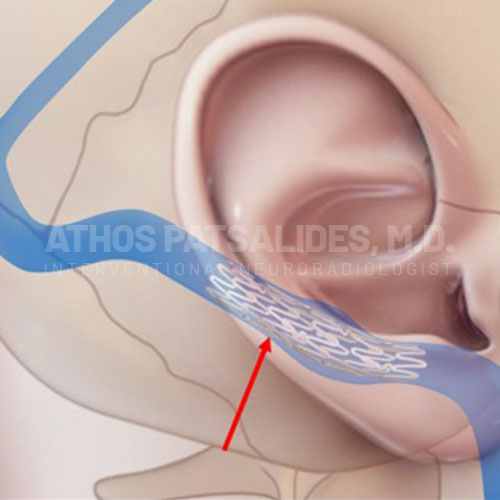Pulsatile tinnitus is sensation of hearing a rhythmic sound in sync with the heartbeat. It is often described as a “whooshing” sound that can range from barely distracting to maddening.
The Pulsatile Tinnitus must be distinguished from non-pulsatile Tinnitus (also called continuous or ringing Tinnitus). As Pulsatile Tinnitus is most commonly caused by vascular problems in the head and neck, it raises concern for underlying significant pathology.
Unfortunately, there is often lack of education in medical professionals and patients are often told erroneously that there is no cure. Pulsatile tinnitus, however, may be caused by several different conditions, ranging from benign to life-threatening, so evaluation and workup by experts are extremely important.
Causes
Vascular Causes
One of the most concerning causes of pulsatile tinnitus are the intracranial arteriovenous shunts which can de subcategorized as Dural Arteriovenous Fistulas (DAVF) and Intracranial Arteriovenous Malformations (AVM).
The DAVF are a lot more common in patients with pulsatile tinnitus and may cause brain dysfunction including brain bleed. The Therefore, they should be detected early and treated if necessary.
Another common and often elusive cause of PT is narrowing of the large veins adjacent to the ear, a condition called Venous Sinus Stenosis. Patients with pulsatile tinnitus and venous sinus stenosis may have IIH.
Narrowing of the arteries of the head or the neck near the ear can also cause pulsatile tinnitus.
ENT disorders that cause PT
Neoplasms called paragangliomas can cause pulsatile tinnitus due to their vascular nature. These benign tumors often require treatment with surgery or radiation. Eustachian tuber dysfunction can be infrequently associated with PT as well
Neurological Disorders
Pulsatile tinnitus can result from muscle spasm of one of the muscles within the ear, or from myoclonus of the palatial muscles. These conditions may be related to underlying neurologic abnormality.
Others
TMJ dysfunction may also cause PT (and non-pulsatile PT).
Diagnosis and Work-up
My personal approach to evaluation of Pulsatile Tinnitus is to use with state-of-the-art, non-invasive imaging as much possible, and reserve invasive tests only for those instances when they are absolutely necessary.
With this in mind, my patients are evaluated with specialized MRI scans that are specifically designed to identify vascular problems from the arteries and veins adjacent to the ear. Specifically, we use high resolution MRA (MRI for arteries) and MRV (MRI for Veins) with the use of intravenous contrast.
A catheter cerebral angiogram is reserved for patients who require further evaluation based on the findings of the MRA and MRV.
Patients may also need additional imaging to identify tumors or problems in the temporal bone and the ear structures, as well as audiometry and tympanometry.
Finally, I may refer patients for additional testing as indicated after the initial work-up.
Treatment
For patients with dural arteriovenous fistulas (DAVF) or intracranial arteriovenous malformations (AVM) or other potentially life-threatening problems, treatment should be considered to prevent any long term risks.
For patients with Venous Sinus Stenosis, a minimally invasive procedure called Venous Sinus Stenting is a great option
The first clinical trial on venous sinus stenting for pulsatile tinnitus is being conducted at Weill Cornell Medicine, with excellent outcomes. With this modality we were able to help many patients with a safe and minimally invasive procedure. The results, which exceeded our expectations will be published in academic journals soon.
-
The illustration shows NORMAL venous sinuses in proximity to the ear. Normal blood flow is from the head towards the neck (white arrows).

-
The illustration shows NARROWED venous sinuses (red arrow) in proximity to the ear. Because of the stenosis there is turbulent blood flow causing pulsatile tinnitus (curved arrows).

-
Stenting alleviates the stenosis, restores normal blood flow and eliminates pulsatile tinnitus.

For other Neurologic or ENT disorders treatment options vary and depend on the underlying etiology and severity of symptoms.
